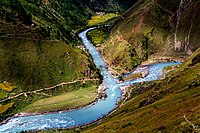
Photo from wikipedia
Abstract This paper deals with the possible provenance of the middle Miocene to early Pleistocene fluvial sediments of the Siwalik Group along with the Karnali River section (Western Nepal) and… Click to show full abstract
Abstract This paper deals with the possible provenance of the middle Miocene to early Pleistocene fluvial sediments of the Siwalik Group along with the Karnali River section (Western Nepal) and adds new insights into the formation and evolution of the Himalayan orogeny by means of detrital zircon U-Pb dating by LA-ICP-MS supplemented with sandstone petrography. The modal composition of the dated sandstone samples shows a ‘recycled orogen’ field in QFL diagram, indicating significant reworking and recycling of the detrital sediments during the mountain building process. The detrital zircon U-Pb ages from the Lower Siwalik cluster around ∼490–600 Ma and ∼750–1300 Ma with major peaks at 560 Ma, 927 Ma, and 983 Ma. The result shows that the Tethys Himalaya, Higher Himalaya and possibly the Lesser Himalaya were the predominant sources during the deposition of the Lower Siwalik Group. Contrarily, the detrital zircon U-Pb ages in the Middle Siwalik rocks contains clusters around ∼299–727 Ma, ∼750–1200 Ma, ∼1650–1900 Ma with major peaks at 469 Ma and 905 Ma. However, the increased input of mid-Proterozoic detritus (∼1600 Ma) points to the possibility of denudation of the lower Lesser Himalaya following the deposition of the lower part of Middle Siwalik (i.e. since ∼10 Ma).
Journal Title: Journal of Asian Earth Sciences
Year Published: 2017
Link to full text (if available)
Share on Social Media: Sign Up to like & get
recommendations!